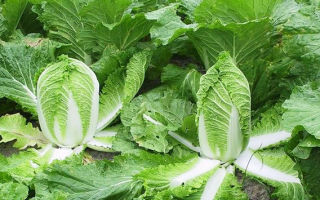Content
- 1 What does Chinese cabbage look like?
- 2 Composition and calorie content of Chinese cabbage
- 3 The benefits of Chinese cabbage
- 4 Can Beijing cabbage be breastfed?
- 5 Chinese cabbage for children
- 6 Features of the use of Chinese cabbage for various diseases
- 7 Peking cabbage recipes in traditional medicine
- 8 The use of Beijing cabbage in cosmetology
- 9 What is the best way to eat cabbage
- 10 What to cook with Chinese cabbage
- 11 How to choose and store Chinese cabbage
- 12 The harm of Chinese cabbage and contraindications to use
- 13 Conclusion
Vegetables take pride of place on every person's table. The benefits and harms of Peking cabbage are due to its rich vitamin and mineral composition, the absence of a typical aroma and delicate fiber structure. If until the 70s a vegetable was a rarity, today it can be found in the garden of every second summer resident. It is planted for fresh consumption and the preparation of various thermally processed dishes.
What does Chinese cabbage look like?
This is a typical member of the Cabbage family. It is an oblong head of cabbage from 30 to 50 cm, formed from tender juicy leaves of yellow-green color. It is a southern crop originally from China, where it was grown before our era. Peking cabbage is a valuable vegetable product in Japan and Korea. Today it is grown on all continents thanks to the emergence of early hybrids that are resistant to different climatic conditions.

The vegetable does not have a characteristic cabbage taste and smell, therefore it is widely used fresh and thermally processed. It is stored no more than 2-3 months, therefore it is grown all year round in open and closed ground.
Composition and calorie content of Chinese cabbage
The taste and useful properties of any product are due to its composition. Like all cabbage ones, Peking cabbage is rich in ascorbic acid, which in its leaves is almost 5 times more than in salad vegetables. Vegetable is a source of fiber, protein, amino acids, antioxidants, macro- and microelements.
Found in its composition:
- iodine;
- potassium;
- magnesium;
- cobalt;
- iron;
- phosphorus;
- selenium;
- lemon acid.
Vegetable is a source of hard-to-digest dietary fiber. Its caloric content is 14-16 kcal per 100 g, which is very valuable for people who are obese and want to lose weight. Nutritionists classify it as a negative calorie product, since it takes more energy to digest it than it gives out.
What vitamins are found in Chinese cabbage
Juicy crispy pekingi leaves are a real cocktail of vitamins diluted in water. A greater amount of biologically active components is concentrated in white veins and stumps. In general, the leaves contain vitamins:
- vitamin C;
- riboflavin;
- folic acid;
- a nicotinic acid;
- carotene;
- thiamine;
- vitamin E;
- vitamin K.

When using Peking cabbage, the bottom is cut off with a thin layer, trying to leave more white stalks. They contain the most vitamin C.
The benefits of Chinese cabbage
Like any vegetable crop, cabbage is prized for its range of positive effects on internal health. It is useful to eat it for anemia and vitamin deficiencies, to strengthen the immune system and improve the production of antibodies to infections.
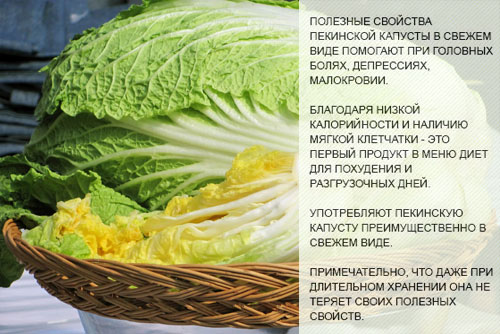
The beneficial properties of Chinese cabbage can be summarized in the list:
- cleans blood vessels from cholesterol;
- normalizes blood pressure, is indicated for hypertension;
- enhances metabolism;
- regulates blood sugar levels;
- improves the production of digestive enzymes;
- enhances intestinal peristalsis;
- cleans the blood;
- has a diuretic effect;
- protects against free radicals.
It is useful to eat cabbage for weight loss and restoration of the nervous system. The benefits of boiled Chinese cabbage are no different from fresh ones. But dishes made from it are much easier for digestion.
Why is Chinese cabbage useful for men
Representatives of the strong half often suffer from liver and cardiovascular diseases. Beijing has amino acids and vitamins that support the health of the main human organs, help cleanse the blood and bile ducts.
Vitamin K has a positive effect on the skeletal system, and zinc - stimulates the production of strong sperm and increases the likelihood of egg fertilization. It is an indirect product that helps with infertility. With regular use of the vegetable, the body's defenses and endurance increase.
The benefits of Chinese cabbage for women
To prolong youth, to cope with the negative effects of free radicals, it is useful for a woman to eat up to 150 g of cabbage a day. Its leaves contain antioxidants that have a positive effect on the condition of the skin and protect it from aging. These are vitamins A and C. There is a lot of lysine in the leaves - an amino acid that strengthens the immune system and prevents cancer.
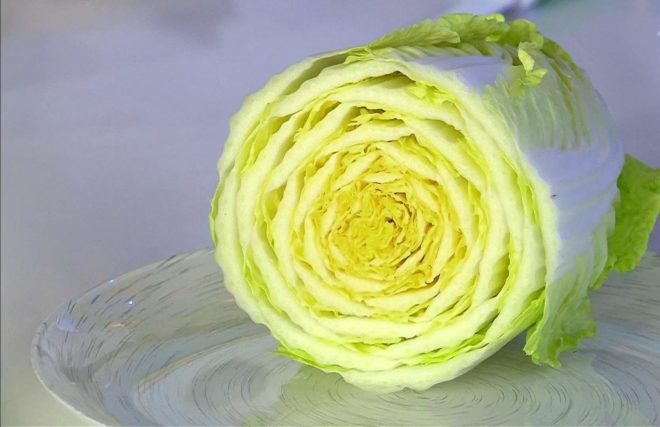
In addition, iodine in the vegetable is important for the stable functioning of the endocrine system - the most important one that regulates the general well-being and the state of the woman's reproductive system. In addition to being eaten fresh and cooked, cabbage leaves are used for cosmetic masks for the face and hair.
Benefits of Chinese salad for pregnant women
The vegetable is valuable as a source of natural vitamins and minerals, which is very important when the need for them increases. In addition, cabbage does not promote weight gain, stimulates urination and relieves swelling.
Pregnant women can eat cabbage fresh and boiled if there is no bloating. It is especially useful to consume a vegetable in the last weeks before childbirth, since vitamin K increases blood clotting, which means it protects a woman from high blood loss during childbirth. Cabbage is a source of natural folic acid and iron, which protects a woman from anemia.
Chinese cabbage for weight loss
It is a welcome product for people looking to lose weight. How does it work:
- stimulates metabolism;
- requires a lot of energy to digest fiber;
- increases vitality, helps with overwork;
- replenishes the lack of vitamins and minerals;
- water source;
- additionally reduces weight due to the diuretic effect and the fight against edema.
Sitting on a diet, cabbage is included in the daily diet fresh and for making soups.
Can Beijing cabbage be breastfed?
Until the baby is 3 months old, it is undesirable for mom to use any types of cabbage. It's all about the high likelihood of developing bloating in a child and digestive problems.
When the child is 3 months old, mom can diversify the diet with a Peking salad with olive oil. You can eat 50 g per day of such a salad.Such a dish is an additional source of vitamins, minerals and other substances that contribute to the physical and mental development of the baby.
Chinese cabbage for children
The vegetable can be included in the child's diet after a year. By this period, the digestive system and the production of all the necessary enzymes are formed in children. Peking cabbage is first introduced into the diet in a boiled form. It is added to vegetable stews and soups. Only after 1.5-2 years can the child be given fresh vegetables. It is useful as a source of vitamins and minerals all year round. It will help to strengthen the immune system, increase hemoglobin, cleanse the liver of toxins in case of prolonged illness and taking antibiotics. If the child does not develop flatulence, cabbage is given 2-3 times a week. It is indicated for vitamin deficiency, diabetes, anemia, insomnia.
Features of the use of Chinese cabbage for various diseases
The benefits of cabbage and any other food product are complex effects due to their multicomponent composition. If for a healthy person there are no restrictions on the use of fresh vegetables, then there are prohibitions for people with chronic diseases. They relate to the volume of consumption, the method of preparation and the combination with other products.
With diabetes
With unstable blood sugar levels, a slow metabolism, hypertension and obesity, Peking is very useful. The benefits are reflected in the stimulation of the production of digestive enzymes and the acceleration of metabolic processes in cells. This is the key to raising blood glucose levels and improving well-being. In addition, the components of the composition cleanse the blood, lower blood pressure and help to lose weight.
With gastritis
With this disease, any type of cabbage is contraindicated. Coarse fiber is difficult to digest, requires active synthesis of digestive juice, which stimulates the production of hydrochloric acid and enzymes. A person with gastritis has heartburn, pain in the abdomen, and a change in acidity levels is possible. Any diseases of the stomach and duodenum 12 are a direct contraindication for eating vegetables.
With bloating (flatulence)
With a tendency to gas production, cabbage is rarely included in the diet. To make the intestines easier to react to plant foods, they are heat-treated. With flatulence, you can eat stewed Chinese cabbage with minimal salt and no spices. The rule of individual product tolerance applies here. Not everyone has a vegetable that causes bloating, but if flatulence is pronounced, they refuse cabbage.
With gout
Peking cabbage is good for fresh gout. Its role is to stimulate the urinary system and cleanse the body of salts and uric acid. It does not contain puric acid, which aggravates the course of the disease. Doctors recommend eating fresh cabbage and adding it when making vegetable juices.
Peking cabbage recipes in traditional medicine
In Japan, the vegetable is considered to prolong life. Folk medicine uses cabbage leaves, juice and seeds. Drink juice for gout, half a glass a day. If diluted with water, you can drink it to normalize stools and improve intestinal motility.
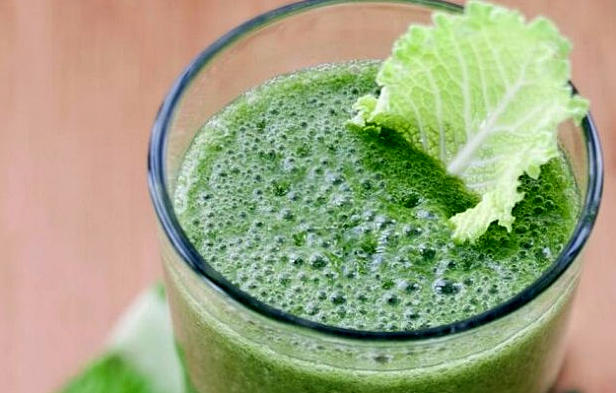
Fresh, slightly beaten with a hammer or knife, leaves are applied to the mammary glands with mastopathy. The components of cabbage relieve swelling, soreness, and promote the resorption of small cysts. To get rid of a dry cough, make an infusion:
- finely chop 2 leaves of cabbage;
- pour a glass of boiling water;
- insist 3 hours.
The infusion is taken in 100 ml 3 times a day 30 minutes before meals. Children make a less concentrated infusion and give 2 tablespoons.
For insomnia, prepare a decoction of fresh cabbage leaves. To do this, pour 200 ml of water into a saucepan and dip 2 whole or chopped cabbage leaves. Simmer on low heat for 15-20 minutes, cool. The broth is taken 1 hour before bedtime, 150 ml.
With inflammation and irritation of the eyelids, an infusion or decoction is also prepared, a cotton pad is moistened in it and applied to the eyelids for 25-30 minutes. For gum disease, you can rinse your mouth with pure juice 3-4 times a day.
The use of Beijing cabbage in cosmetology
Water is the source of beauty and youthfulness of skin and hair. Peking cabbage is 95% water, therefore it is considered a good moisturizer, saturates cells with moisture and vitamins, especially A and C. To prepare a mask for dry skin, you need:
- Boil 2 cabbage leaves in milk until soft;
- knead with a fork until gruel;
- add olive oil and whipped yolk;
- apply to skin for 20 minutes.
The product moisturizes, relieves inflammation, exfoliates and enhances the immunity of skin cells. To moisturize, you can simply hold the leaves in boiling water and apply them to the face and décolleté for 15-20 minutes. The procedure is carried out 3 times a week.
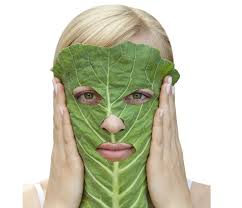
For normal skin, you can grind a cabbage leaf, a spoonful of cottage cheese, boiled water, honey and lemon juice in a blender. Ingredients are taken in any form, the consistency should be creamy. The mass is slightly warmed up in a water bath to combine the components. This mask can be done in winter to nourish and moisturize the face.
Cabbage masks are made to moisturize and nourish hair. For their preparation, take fresh leaves, grind in a blender and add additional ingredients depending on the type of curls:
- for dry - olive and other oils, egg yolk, aloe juice;
- for fat - kefir, aloe juice, honey;
- for those prone to dandruff - aloe, mustard powder.
To make the effect of cabbage masks noticeable, they are done systematically 2-3 times a week for a month.
What is the best way to eat cabbage
Fresh vegetable is the most valuable. All vitamins, minerals and amino acids are preserved in their natural form. Delicate crispy leaves are put in salads, they are used to decorate second courses. For fresh consumption, cut off the bottom and tear the leaves into pieces with your hands. The tougher stumps are cut with a knife.
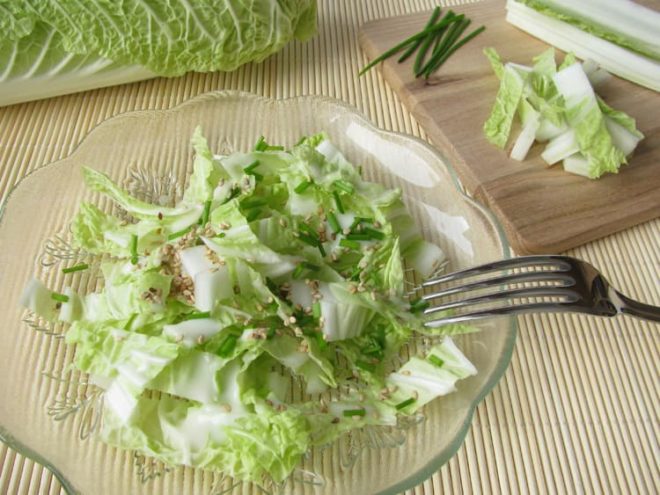
In Japan and other Asian countries, Peking cabbage is pickled, boiled, and fermented. It is added to soups, vegetable and meat stews. So that it retains some of the nutrients, it is added at the end of cooking - in 5 minutes. When preparing salads, cabbage is combined with fats for better absorption of vitamins. It can be olive and other vegetable oil, sour cream, homemade mayonnaise. In salads, cabbage is combined with:
- carrots;
- cucumbers;
- tomatoes;
- greens;
- chicken fillet;
- canned peas, corn;
- apples;
- mushrooms;
- seafood.
The benefits of fried Chinese cabbage are low. During heat treatment, it loses most of its nutrients, although valuable dietary fiber is retained. As such, it is approved for the nutrition of people with digestive problems. A healthy person can eat no more than 200 g of fresh vegetables per day.
What to cook with Chinese cabbage
The most recognizable Chinese cabbage dish and the national dish of Japan and Korea is kimchi. This is cabbage marinated with spices - very spicy and piquant, which is used both independently and in combination with meat and bread. In addition to kimchi, at home from Peking cabbage, you can cook:
- casserole;
- cabbage rolls;
- borscht;
- dietary salad with cucumber and Wochester sauce.
Cabbage is stewed with carrots and onions, used as a filling for lavash and pancakes. It is good for warm salads with red fish and tuna. Whole Peking cabbage can be stuffed with various fillings and used as a snack.
How to choose and store Chinese cabbage
You can buy Chinese cabbage all year round. To make dishes from it tasty and healthy, it is important to choose and store it correctly. In the store, preference is given to medium-sized heads of cabbage, dense and heavy with elastic crispy leaves of a juicy yellow-green color.
The dark edge of the leaves, lethargy and signs of decay indicate improper storage, prolonged storage or damage by microorganisms.
When growing, Peking often uses chemical fertilizers. To reduce their content in a vegetable, it is completely immersed in a container with cold boiled water for 1-1.5 hours. Later, the head of cabbage is shaken, dried and the intended dish is prepared.
The harm of Chinese cabbage and contraindications to use
A vegetable is a valuable food product, but it is not devoid of contraindications for use. It can harm health when combined with dairy products: nausea and diarrhea may develop. If a person suffers from gastritis, stomach ulcers and high acidity, cabbage is contraindicated. Its use is fraught with the development of heartburn and pain.
It is undesirable to give it to children under one year old and to people prone to allergies to plant foods. The citric acid in the composition of Peking irritates the esophagus during inflammation. The rest of the vegetable is included in the diet in acceptable amounts.
Conclusion
The benefits and harms of Chinese cabbage are contained in its chemical composition. A vegetable is an excellent dietary product suitable for fresh and processed consumption. With its help, the deficiency of vitamins in the winter is replenished, they lose weight and preserve beauty and youth.

